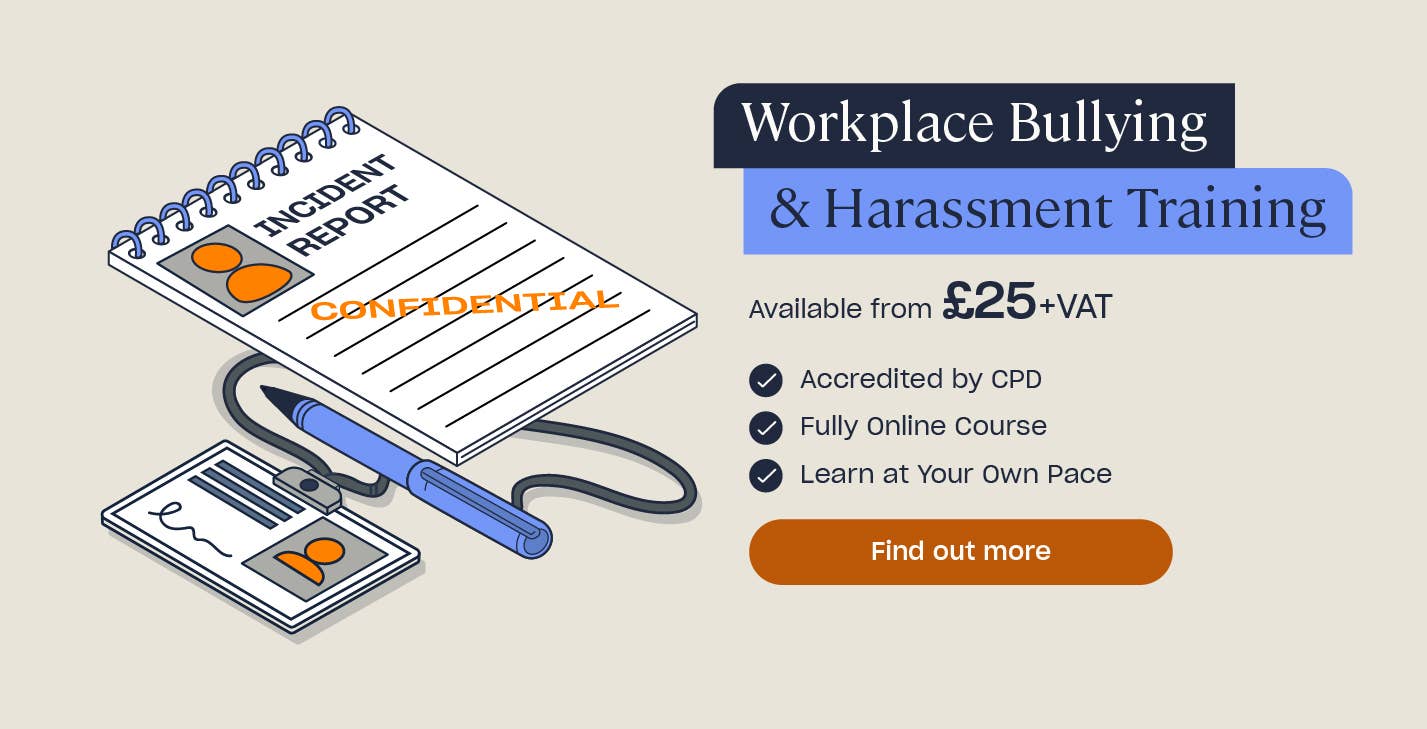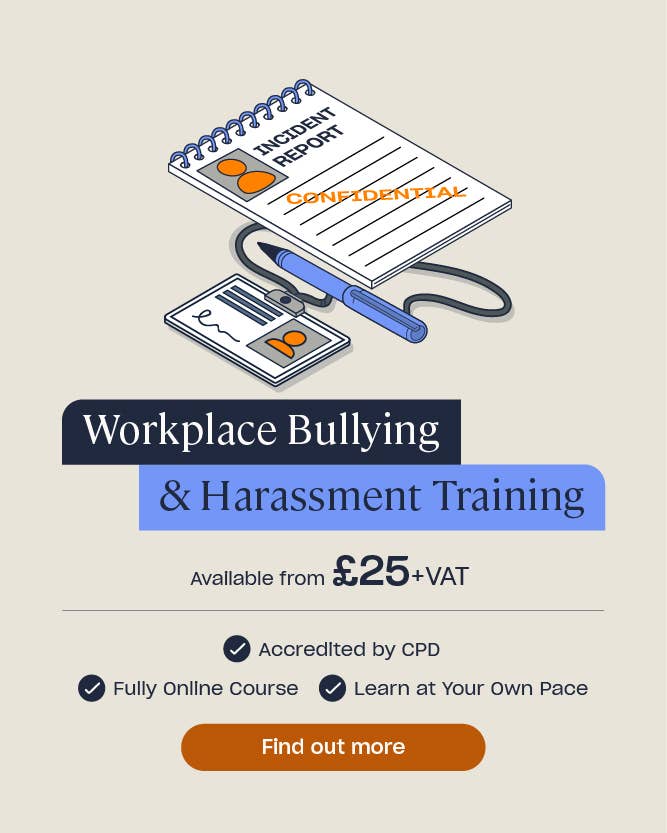Am I Being Bullied at Work? 12 Signs of Bullying in the Workplace
Bullies are not confined to the school playground and age and location does not protect people from experiencing bullying. Bullying of any kind must not be tolerated and all employees deserve to work in a safe and inclusive environment. Nevertheless, bullying in the workplace continues to be a prevalent issue with 25% of employees experiencing conflict or abuse in 2024. Bullying can take many forms ranging from insidious harmful comments that are hard to call out to more overt instances of physical or verbal abuse. Irrespective of the form that it takes, proactive steps should be taken to ensure that workplace bullying is not allowed to thrive in your environment. This article will outline what workplace bullying is and the signs of bullying that you should look out for. We will also provide you with guidance on what to do if you suspect that bullying is occurring in the workplace.
What is Workplace Bullying?
The trade union UNISON defines workplace bullying as persistent offensive, intimidating, humiliating behaviour, which attempts to undermine an individual or group of employees. Bullying can take many forms and can occur in a wide range of situations which can make it hard to identify. However, bullying of any kind is unacceptable and must be addressed before it continues to undermine an employee’s right to be treated with dignity and respect.
The terms bullying and harassment are often used interchangeably however there is a difference between the two. Whilst both types of behaviour are harmful and can reflect an abuse of authority, it is important to understand the difference as the legal ramifications for harassment tend to be greater. Harassment typically refers to unwanted conduct that seeks to humiliate or undermine an individual group. However, unlike bullying, harassment is caused by prejudice against specific groups and/or protected characteristics. The Equality Act 2010 established nine protected characteristics and if someone is subjected to abuse because of a protected characteristic then that is classed as harassment.

Most discriminatory behaviour is illegal in the UK and so there is specific legal action that can be taken in the case of harassment. For example, making an inappropriate comment about an employee’s sex life based on their gender could be deemed sexual harassment. Moreover, providing overbearing and condescending supervision for an employee who suffers from depression, could be deemed mental health discrimination. In both instances, there are notable legal ramifications to this discrimination and harassment.
Signs of Bullying at Work
As mentioned, bullying can take on many forms and that can make it hard to spot. Some forms of bullying are much easier to spot than others as they are more overt and may involve direct physical or verbal abuse. Comparatively, other forms of bullying can be much more insidious and indirect such as excluding someone or spreading rumours about them. Whilst it can be hard to identify bullying, it’s important that you are aware of the signs so that you know when to take action.
Common signs of workplace bullying include:
- Constant criticism
- Removal of duties without reason
- Overbearing supervision or monitoring
- Threats, aggression and shouting
- Being put down, picked on (either in private or in front of others) and made to feel like the butt of the joke
- Being excluded and ignored
- Having malicious rumours spread about you
- Unwelcome sexual advances
- Misusing a position of power to belittle, demean, or intimidate
- Refusing reasonable requests
- Unfounded threats and comments about job security
- Blocking promotion, progress, or training opportunities
Want to Learn More?
Our Workplace Bullying & Harassment Training explores the difference between bullying and harassment, the laws that protect workers from harassment and the laws that make bullying a statutory duty for employers. You can also find a range of Business Essentials courses here.
Types of Bullies at Work
Workplace bullying can happen between anyone in the work environment; it could be between peers or between a manager and their employee. Bullying of any kind must not be tolerated, however bullying can be harder to spot when it is from a manager. It can often be interpreted as ‘tough love’ or simply how that manager gets results. However, this is no excuse for bullying or treating employees poorly.
Bullying between peers may be easier to spot, however that doesn’t make it easier to report. Bullying between peers can easily be dismissed as ‘banter’ and the person being subjected to the bullying can be deemed as ‘over reacting.’ Moreover, peer pressure can create a culture of silence in which people are afraid to challenge bullying behaviour and upset the status quo.

Below you find a list of behaviours that may indicate that a manager and peer/colleague is demonstrating bullying behaviour.
Bullying by a Manager
You may be being bullied by your manager if they:
- Threaten you – Threatening can encompass a wide range of behaviours, including threatening to fire you, making threatening gestures, or threatening to physically harm you. This also includes aspects of intimidation, such as invading your space and towering over you.
- Verbally abuse you – Verbal abuse is a highly indicative sign that your boss is a bully. This includes shouting at you, swearing at you, making snide remarks, unfair and unwarranted criticism and making offensive and humiliating jokes at your expense. Verbal abuse can occur both in private and in front of others.
- Question your abilities – A ‘bully boss’ could frequently question your abilities, skills, ideas and accomplishments. They could belittle your work and decrease your confidence in your adequacy to perform your job role.
- Undermine your work – As well as undermining your work by questioning your skills and abilities, they may undermine your work in other ways. They may regularly change your assigned tasks (sometimes without telling you), withhold necessary information, give you more work than you can handle and make overly critical and unjustified comments about your work.
- Intrude on your privacy – Signs that somebody is intruding your privacy include them listening in on your conversations, watching your behaviours, opening your mail, looking through your possessions, or even spying on you.
- Hinder your chances of success – A boss who is bullying you may deny you promotions and additional training, all to stop you from progressing. They may also closely monitor and try to manage all your projects.
- Isolate you – Isolating people socially is a way for a ‘bully boss’ to gain control and make you doubt yourself. They may exclude you from social events, company outings and even from mailing lists.
- Spread rumours about you – If a bully is wanting to make you look bad, they may gossip about things such as your appearance and your abilities. They may also spread rumours about your personal life.
Bullying by a Peer/Colleague
The bullying exhibited by a peer or colleague is likely to be similar to that exhibited by a manager, however, as they are unlikely to have equal authority within the workplace it may be more insidious and therefore slightly harder to spot. You may be being bullied by a peer/colleague if they:
- Exclude and ignore you – Bullies may exclude you from the wider group both socially and in a work capacity. For example, they may conspicuously exclude an individual from social events or conversations, or ignore individuals for work opportunities such as collaborating on a project.
- Ridicule you – Ridicule is often used to undermine and humiliate someone and to encourage others to question their integrity/authority. Peers who are bullying others may go out of their way to ridicule an individual to reaffirm their ‘superiority’ over them and to humiliate them in the eyes of others.
- Tell you offensive or inappropriate jokes – Whilst this type of bullying behaviour is very common it can also be very hard to spot and define. Bullies often hide behind this fact to make offensive and inappropriate comments to someone, under the guise of it simply ‘being banter’ or claiming that the joke was misinterpreted if someone becomes offended.

How to Deal with Bullying at Work
Bullying can be incredibly damaging to one’s mental and physical health and if left unchecked it can create a toxic work environment in which employees do not feel safe and supported. It is therefore vital that bullying is tackled immediately and that all signs of bullying are treated seriously.
There are several different ways in which bullying can be tackled in the workplace. These include:
- Creating a positive environment – Whilst this won’t necessarily stop an individual from attempting to bully others, it will create an environment in which bullying behaviour is not tolerated in any way. As such, it becomes easier to spot and others are more willing to call it out immediately as they know and trust that it will be handled correctly.
- Encouraging clear communication – Many people are hesitant to admit that they are being bullied, either out of fear that they won’t be believed or because the behaviour itself is hard to explain. By encouraging clear communication you can embolden staff to speak up about what they may be experiencing and also to speak up for one another.
- Documenting what you see – Discreetly recording details of bullying behaviour as they occur provides you with proof which can be presented to HR in order to tackle the situation.
- Reporting the behaviour – Reporting bullying behaviour holds the bully accountable and ensures that the company addresses the issue in the best way.

How to Report Bullying at Work
If you are experiencing any bullying behaviour, it’s important that you speak up. This is not only important for your own wellbeing, but you may also be unknowingly helping other colleagues who are experiencing the same thing.
The first action you can take, if you feel comfortable to do so, is to speak directly to the person who is behaving in this way. It may be that they do not realise what they are doing, or how their behaviour is affecting you. Be clear with how you feel and try to stay calm.
If you do not want to do this, or if you have already done so and the behaviour has continued, you could report it to any of the following:
- Your line manager. This person is responsible for supporting you and your wellbeing at work. If you do not feel comfortable speaking to them, for example if they are the one demonstrating the behaviour, you could speak to another manager.
- Your HR department. They have a responsibility to investigate and take matters such as these further. This may involve them speaking to the perpetrator and offering you any support that you need.
- Your trade union representative. If you have a union representative then they can help you to agree on a way forward and speak up for you if you are uncomfortable doing so yourself.
If none of the above are suitable for your circumstances, you could make a formal complaint using your organisation’s grievance procedure. In addition, if you need any further help or advice, you could contact Acas, an independent public body that provides advice on dealing with workplace conflict.
Unfortunately the workplace is not exempt from bullying nor are bullies confined to the school playground. Adults can be just as prone to becoming bullies as children and when left unchecked this behaviour can create a toxic workplace culture of fear and intimidation. Bullying can take on many forms; some more overt than others, some more insidious. Nevertheless everyone deserves to be treated with dignity and respect at work and bullying of any kind undermines this right. There is no excuse for bullying and if you suspect that you are being bullied then you must report it as soon as possible.
Further Resources:
- Abuse of Authority in the Workplace
- Sexual Harassment in the Workplace: What Is It and How Do I Report It?
- Workplace Bullying & Harassment Training







